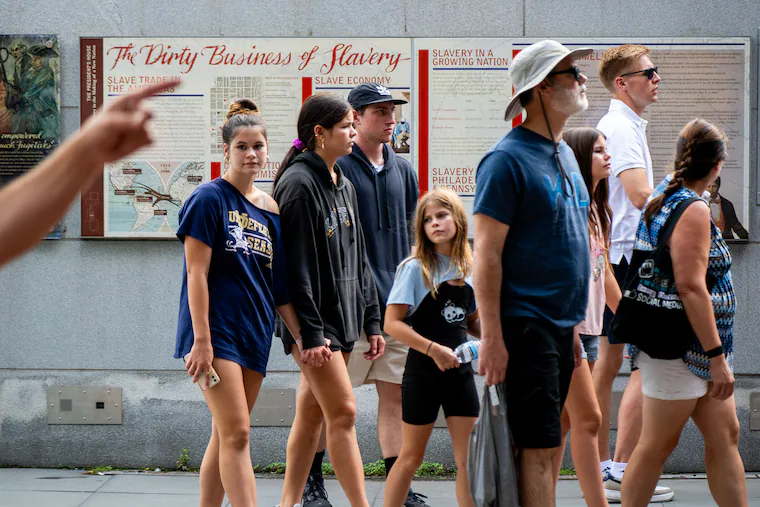
The Trump administration has ordered the removal of signs and exhibits related to slavery at multiple national parks, according to four people familiar with the matter, including a historic photograph of a formerly enslaved man showing scars on his back.
The individuals, who spoke on the condition of anonymity because they were not authorized to speak with the media, said the removals were in line with President Donald Trump’s March executive order directing the Interior Department to eliminate information that reflects a “corrosive ideology” that disparages historic Americans. National Park Service officials are broadly interpreting that directive to apply to information on racism, sexism, slavery, gay rights or persecution of Indigenous people.
Following Trump’s order, Interior Department officials issued policies ordering agency employees to report any information, including signage and gift shop items, that might be out of compliance. Trump officials also launched an effort asking park visitors to report offending material, but they mostly received criticisms of the administration and praise for the parks.
The latest orders include removing information at Harpers Ferry National Historic Park in West Virginia, two people familiar with the matter said, where the abolitionist John Brown led a raid seeking to arm slaves for a revolt. Staff have also been told that information at the President’s House Site in Philadelphia, where George Washington kept slaves, does not comply with the policy, according to a third individual.
Jonathan Zimmerman, a University of Pennsylvania professor who studies the history of education, said this is the latest installment in the Trump administration’s unprecedented interference with the nation’s civic institutions – a campaign which also includes Trump’s takeover of the Kennedy Center and attempts to pressure the Smithsonian.
“This represents an enormous increase in federal power and control over the things we learn,” Zimmerman said. “Brought to you by the team that says education should be state and local.”
Park Service spokesperson Rachel Pawlitz said in a statement that all signage is under review.
“Interpretive materials that disproportionately emphasize negative aspects of U.S. history or historical figures, without acknowledging broader context or national progress, can unintentionally distort understanding rather than enrich it,” Pawlitz said.
At Harpers Ferry, staff flagged more than 30 signs, according to a person familiar with the matter and documents reviewed by The Post, that highlight information potentially in violation of Trump’s policy. They include signs referring to racial discrimination and the hostility of White people to people who were formerly enslaved.
Park Service officials marked the submission as “out of compliance,” with staff now expected to cover up parts of signs or remove them, the person said.
Separately, Park Service officials have ordered the removal of a photograph illustrating violence against slaves, known as “The Scourged Back,” at one national park. The photograph, taken in 1863, shows scars on the back of a man probably named Peter Gordon from wounds inflicted by his masters before he escaped slavery.
The photo was circulated widely at the time, and Northern audiences were shocked at what the photo showed, said Anne Cross, a scholar of 19th century photography at Bowdoin College Museum of Art.
“The bodies of enslaved people like Peter Gordon revealed to them realities they had never seen with their own eyes before,” Cross said, “and in many cases it altered their political opinions about the need to defeat the Confederacy and preserve the Union.”
The photo has since become iconic, taking on a greater meaning in the struggle for Black liberation, Cross said. The New Yorker integrated the image into a collage on its cover commemorating George Floyd, a month after his death at the hands of police. Later that year, Viola Davis appeared on the cover of Vanity Fair showing her back, with photographer Dario Calmese acknowledging that he sought to replicate the historic photo.
In his executive order, Trump singled out the “corrosive ideology” at Philadelphia’s Independence National Historical Park, where the founders signed the Declaration of Independence.
That park includes the President’s House Site, where George Washington served as president before the capital moved to Washington, D.C. The house was demolished in the 1800s, but an exhibit opened there in 2010 based on archaeological excavations.
Local advocates had pushed for the exhibit to provide in-depth information on the lives of nine people who were enslaved by George Washington while he lived in the house as president. The exhibit includes their names carved into a granite wall.
“This is not just a handful of signs that tell the story of slavery,” said Ed Stierli, senior Mid-Atlantic regional director at the advocacy group National Parks Conservation Association. “This is a place that tells the complete story not just of slavery in America, but what it was like for those who were enslaved by George Washington.”
Trying to extricate slavery from the President’s House exhibit would fundamentally change the nature of the site, said Cindy MacLeod, who was superintendent of Independence National Historical Park for 15 years until 2023.
“This is just one of many exhibits at Independence National Historical Park,” MacLeod said. “And to me, it’s a vital one.”



